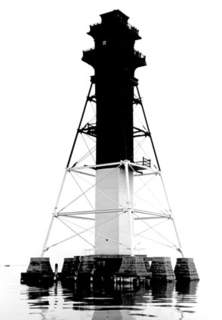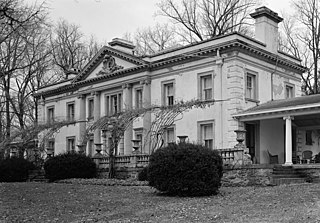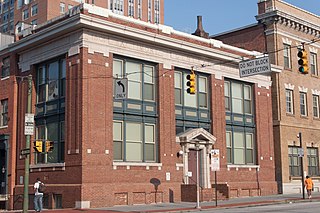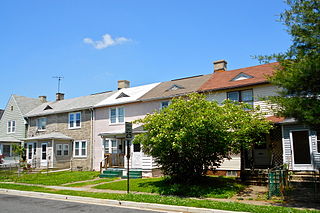
The Craighill Channel Lower Range Rear Light is one of a pair of range lights that marks the first section of the shipping channel into Baltimore harbor. It is the tallest lighthouse in Maryland.

Mount Clare, also known as Mount Clare Mansion and generally known today as the Mount Clare Museum House, is the oldest Colonial-era structure in the City of Baltimore, Maryland, U.S.A. The Georgian style of architecture plantation house exhibits a somewhat altered five-part plan. It was built on a Carroll family plantation beginning in 1763 by barrister Charles Carroll the Barrister, (1723–1783), a descendant of the last Gaelic Lords of Éile in Ireland and a distant relative of the much better-known Charles Carroll of Carrollton, (1737–1832), longest living signer of the Declaration of Independence and the richest man in America in his later years, also the layer of the First Stone of the new Baltimore and Ohio Railroad, just a short distance away in 1828.

The Bowie Railroad Buildings comprise three small frame structures at the former Bowie train station, located at the junction of what is now the Northeast Corridor and the Pope's Creek Subdivision in the town center of Bowie, Maryland. The complex includes a single-story freight depot, a two-story interlocking tower, and an open passenger shed. The station was served by passenger trains from 1872 until 1989, when it was replaced by Bowie State station nearby. The buildings were restored in 1992 as the Bowie Railroad Museum and added to the National Register of Historic Places in 1998.

Brooklandville House, or the Valley Inn, is a historic restaurant and tavern building, and a former inn, located in Brooklandville, Baltimore County, Maryland. It is a 2+1⁄2-story stone structure facing the former railroad and dating from about 1832. It is associated with the Baltimore and Susquehanna Railroad, which crossed the property just to the south.

Hilton is a historic home located at The Community College of Baltimore County in Catonsville, Baltimore County, Maryland. It is an early-20th-century Georgian Revival–style mansion created from a stone farmhouse built about 1825, overlooking the Patapsco River valley. The reconstruction was designed by Baltimore architect Edward L. Palmer, Jr. in 1917. The main house is five bays in length, two and a half stories above a high ground floor, with a gambrel roof. The house has a 2+1⁄2-story wing, five bays in length, with a gabled roof, extending from the east end; and a two-story, one-bay west wing. The roof is covered with Vermont slate. The house features a small enclosed porch of the Tuscan order that was probably originally considered a porte cochere.

Towson Academy is a historic National Guard armory building located at Towson, Baltimore County, Maryland. It is a two-story brick structure constructed in 1933 with full basement, faced with a smooth light-colored, marble-like stone veneer. It features a T-shaped plan with a two-story front "head house" section and a one-story perpendicular "drill hall" extending to the rear and its façade is detailed to recall Medieval fortifications, with towers flanking the central entrance.

Liriodendron is a historic home and estate located at Bel Air, Harford County, Maryland, United States. It was the summer home of Laetitia and Dr Howard Kelly, a successful surgeon and founding member of the Johns Hopkins Medical College, and comprises the mansion named Liriodendron; the Graybeal-Kelly House; a c. 1835 bank barn; a c. 1898 carriage house; a c. 1850 board-and-batten cottage; and five other outbuildings including a corn crib, a smokehouse, two ice houses, and a shed. The 2+1⁄2-story, stuccoed brick mansion was designed by the Baltimore architectural firm of Wyatt and Nolting in the Georgian Revival style and constructed about 1898. The 2+1⁄2-story Georgian-style Graybeal-Kelly House, built about 1835, was the manor house for the farm until the mansion was constructed. It is used as a wedding, conference, and arts facility.

Olney, originally patented as Prospect, is a historic home and farm complex located at Joppa, Harford County, Maryland. It is a 264-acre (1.07 km2) working pony farm with a collection of 15 structures ranging in style, use, and elegance. The main building on the property is a 2+1⁄2-story brick house dating to 1810, generally called "the mansion." The house was evolved into a museum of Maryland architecture, with salvaged features from demolished buildings in Baltimore and Philadelphia. These include paneling from the Isaac Van Bibber house in Fells Point, Baltimore dating to 1815; the marble Ionic portico from William Small's Baltimore Athenaeum from 1830; and a marble bas-relief plaque designed by Pierre L'Enfant for Robert Morris's great 1795 house in Philadelphia. Also on the property is an early-18th-century, 2+1⁄2-story stone dwelling and a variety of still-functioning farm structures that in themselves range in style from simple stone stables and frame hay barns to an unusual two-story brick blacksmith's shop. In addition, the 1914 Union Chapel School, was moved onto the property in 1980 and re-outfitted as St. Alban's Anglican Church. The property was developed by J. Alexis Shriver (1872–1951), a man prominent in local and state historical and agricultural matters who lived at Olney from 1890 until his death.

Slate Ridge School is a historic school located at Whiteford, Harford County, Maryland. The main block of the building is two stories, constructed of brick with a slate hip roof and a small wooden cupola in the center. It was built in 1912, and designed by the Baltimore architect Otto Simonson. A narrow hyphen containing a stairwell and corridor connects the main block to a similar two-story rectangular block and a one-story wing containing a stage and gymnasium, added just after World War II. It was used until about 1980.

Buildings at 10, 12, 14, and 16 East Chase Street is a historic set of rowhouses located at Baltimore, Maryland, United States. Number 10 is a 3+1⁄2-story brick townhouse with a 3-bay front façade, fitted with marble facing from ground to first floor level. It is believed to have been designed by Bruce Price and / or E. Francis Baldwin, architects of neighboring Christ Church. Numbers 12, 14, and 16, by contrast, are identical 3+1⁄2-story, two-bay houses constructed of green serpentine marble with contrasting stone detail. The group dates from between 1870 and 1875. They represent a fine example of the Gothic Revival style as interpreted for domestic architecture.

Engine House No. 8 was a historic fire station located at Baltimore, Maryland, United States. It was a two-story masonry building with a cast-iron street front, erected in 1871 in the Italianate style. The front featured a simple cornice with a central iron element bearing the legend "No. 8". Engine Company No. 8 operated from this building until 1912. In 1928 it became the motorcycle shop of Louis M. Helm and the upper story functioned as a clubhouse for a series of boys’ clubs into the 1940s.

Baltimore General Dispensary is a historic public dispensary building located at Baltimore, Maryland, United States. It opened in 1801 to provide medical and health services to the poor in Baltimore. It is the oldest institution of its kind in Maryland. It is three bays wide and two stories high, with running bond red brick foundation and building walls, and a water table constructed in 1911. The front features a simple cornice surmounting a stone entablature reading: 1801 Baltimore General Dispensary 1911. It is the only surviving building designed for Baltimore's oldest charity. The interior originally featured a large dispensary center on the first floor, separated for black and white patients. The rooms for surgical and medical aid on the second floor gave the poor a measure of privacy rarely available to charity patients.

Johnston Building was a historic wholesale building located at Baltimore, Maryland, United States designed by Jackson C. Gott. It is a five-story loft building constructed in 1880. The cast iron façade reflected the influence of the Queen Anne style. It housed wholesale companies dealing in tobacco, hats, shoes, clothing, and home and office furnishings, including Samuel Hecht, Jr. & Sons. It was demolished in 2002.

G. Krug & Son Ironworks is a historic iron works located at Baltimore, Maryland, United States. It is a complex consisting of a two-story tall gable-roofed building dating from the first quarter of the 19th century, which houses the earliest shop; a four-story tall Victorian building which houses a business office on the first floor and storage rooms on the upper floors; and a three-story tall shed-roofed addition dating from 1870 to 1880. It is in its fifth generation as a family business.

James E. Hooper House is a historic home located at Baltimore, Maryland, United States. It is a large Queen Anne style freestanding masonry structure, situated among the buildings of the Old Goucher College Buildings complex. It is a rectangular building with a steeply pitched gable roof, a small, two-story wing extending, and a 2+1⁄2-story bay window extension, with a small gable roof. There are two stories in the main section of the house, and two more stories in the gable. It is constructed of dark red bricks with terra cotta, brownstone, and granite trim. The exterior features a slate shingle roof, and a square oriel, three bays wide and one bay deep, made of wood, and painted green. The house was constructed in 1886 for James E. Hooper (1839–1908).

Industrial Building is a historic factory building located at Baltimore, Maryland, United States. It is a large seven story industrial-style structure built in 1912 and designed by Baltimore architect Theodore Wells Pietsch. It features an "E" plan, reinforced concrete and steel-frame construction, and large pivoted-sash windows. The front façade is characterized by a symmetrical window arrangement and a large 2-story, round-arched entranceway. It was scheduled for conversion to housing for the elderly during the 1980s.

Coca-Cola Baltimore Branch Factory is a historic factory complex located at Baltimore, Maryland, United States. It was constructed from 1921 to 1948 and built principally to house Coca-Cola's syrup-making operations. The complex is spread over a 9.4-acre (38,000 m2) site and includes a two-story brick syrup factory/sugar warehouse and an earlier two-story brick mattress factory that Coca-Cola acquired and adapted in the 1930s. Completed in 1948, the complex housed syrup-making operations as well as the Coca-Cola Company's chemistry department.

Building at 239 North Gay Street, also known as Spartana Electronics, is a historic building located at Baltimore, Maryland, United States. It is a tall three-story iron-front structure of Italianate style built in 1875. It represents a Full Cast Iron Front and Major Exterior Cast Iron Detail type building. It was altered at street level by the construction of a modern store façade. Large window openings are flanked by Corinthian columns and headed by segmental arches. In 1974, the property was purchased by Anthony R. Spartana, who founded an electronic supplies business in 1925.

Little Montgomery Street Historic District is a national historic district in Baltimore, Maryland, United States. It is composed of approximately 15 19th century brick houses, some of which are double, that line the 100-block of West Montgomery Street and the northwestern portion of the 800 block of Leadenhall Street. All the buildings are small in scale and of brick construction, abut the sidewalks, are closely spaced, and are generally two to three stories high with two-bay façades. Nine of the structures are "half houses" that are only one room deep with a single pitch roof. The district is associated with a working class urban community where, throughout the 19th and early 20th centuries Baltimore's native poor, struggling German and Irish immigrants, and freed southern African-Americans lived side by side competing for the same space and the same railroad and port-related jobs.

Dundalk Historic District is a national historic district in Baltimore, and Baltimore County, Maryland, United States. The district is a cohesive unit made up of residential, commercial, and institutional buildings with structures that generally date from 1910 to 1940. Major architectural styles represented include Period Revival and Art Deco/Streamline Moderne. The District includes 962 resources contribute to its significance. It includes the only two housing developments built by the United States Shipping Board Merchant Fleet Corporation (EFC) in Maryland during World War I and reflects experimentation with Garden City planning ideals. Many of the buildings within the District represent the work of noted Baltimore architect Edward L. Palmer, Jr.


























